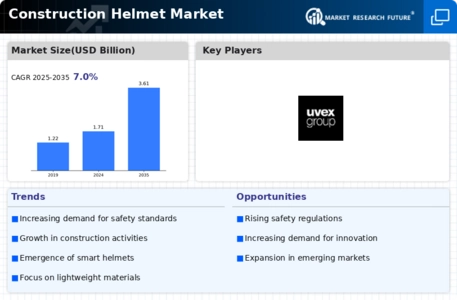Market Trends
Key Emerging Trends in the Construction Helmet Market
The Construction Helmet market is undergoing significant trends, reflecting the evolving landscape of workplace safety and the construction industry's commitment to ensuring the well-being of workers. Construction helmets, also known as hard hats, are critical personal protective equipment (PPE) designed to protect workers from head injuries in hazardous construction environments.
One noteworthy trend in the Construction Helmet market is the integration of advanced technologies for enhanced safety. Smart helmets equipped with sensors, communication systems, and augmented reality features are gaining traction. These innovations provide real-time data on a worker's health, location, and environmental conditions, contributing to improved safety management on construction sites. The incorporation of technology into construction helmets aligns with the industry's push for digitalization and the Internet of Things (IoT) in safety practices.
The construction industry's growing emphasis on sustainability is influencing trends in the Construction Helmet market. Manufacturers are exploring eco-friendly materials and production processes to reduce the environmental impact of helmet manufacturing. Sustainable helmet options made from recycled or recyclable materials are gaining popularity, reflecting the broader industry shift toward green construction practices and corporate responsibility.
Customization and personalization are key trends in the Construction Helmet market. Companies are offering a range of colors, designs, and branding options to allow workers to personalize their helmets. This trend not only adds a touch of individuality but also contributes to a sense of ownership and pride in safety gear. Customized helmets also serve as a visual identifier for workers, enhancing team cohesion and communication on construction sites.
The Asia-Pacific region is a significant player in the global Construction Helmet market. Rapid urbanization, infrastructure development, and construction activities in countries such as China and India contribute to the high demand for construction helmets. The region's stringent safety regulations and the focus on improving workplace safety standards are driving the adoption of quality helmets across construction projects.
Technological advancements in helmet design and materials are shaping trends in the Construction Helmet market. Lightweight yet durable materials, such as high-impact thermoplastics and fiberglass, are being used to create helmets that provide optimal protection without compromising comfort. Improved ventilation systems, adjustable straps, and ergonomic designs contribute to enhanced wearer comfort, promoting long-term usage compliance.
Increased awareness of the importance of head protection is driving the Construction Helmet market. Educational campaigns, safety training, and regulatory initiatives emphasize the significance of wearing helmets on construction sites. The cultural shift toward prioritizing safety has resulted in a higher demand for quality helmets that comply with industry standards and certifications, contributing to a safer working environment.
The COVID-19 pandemic has influenced trends in the Construction Helmet market, with an increased focus on hygiene and worker well-being. Helmets with anti-microbial coatings, moisture-wicking liners, and ventilation systems that reduce heat and discomfort have gained attention. The pandemic has accelerated the adoption of hygiene-focused features in PPE, reflecting the industry's commitment to safeguarding the health of construction workers.
Strategic partnerships between helmet manufacturers and technology companies are shaping the market. Collaborations aim to enhance helmet functionalities by integrating features such as communication systems, safety sensors, and real-time monitoring capabilities. These partnerships leverage the expertise of both safety equipment manufacturers and technology providers to create comprehensive solutions for construction site safety.
The Construction Helmet market is influenced by evolving safety standards and regulations. Regulatory bodies worldwide are continually updating and refining safety requirements for construction sites. Compliance with these standards is a key consideration for manufacturers, influencing the design, materials, and features of construction helmets to meet or exceed the specified safety criteria.
Fluctuations in raw material prices, particularly those related to high-performance plastics and impact-resistant materials, impact the Construction Helmet market. The availability and cost of materials such as polycarbonate and fiberglass influence the overall cost structure of helmet production. Market participants closely monitor these raw material dynamics to manage potential cost fluctuations and maintain competitiveness.


 Source: Secondary Research, Primary Research, Market Research Future Database and Analyst Review
Source: Secondary Research, Primary Research, Market Research Future Database and Analyst Review

Leave a Comment